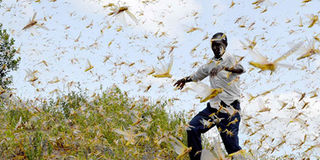Brace for dramatic increase in locust swarms, FAO says

A man in Kiplekwa village, Baringo County, tries to chase away desert locusts on February 23, 2019. PHOTO | FILE | NATION MEDIA GROUP
What you need to know:
- UN body says the pests could be up to 20 times larger than the previous swarm.
Widespread rainfall that happened in March is expected to produce a dramatic increase in locust numbers in Kenya and cross the region over the coming months, the Food and Agriculture Organization (FAO) has warned.
The warning by the UN agency comes as scientists have raised the alarm over a new breed of insects that is adapting to aerial spraying intervention by hiding under leaves and dispersing.
The FAO warns that new swarms expected to hatch in May will be descendants of the first generation, further noting that the pests could be up to 20 times larger than the previous swarm.
"The current situation in East Africa remains extremely alarming as more swarms form and mature in northern and central Kenya, southern Ethiopia and probably in Somalia. This represents an unprecedented threat to food security and livelihoods because it coincides with the beginning of the long rains and the planting season," FAO said in an update
"Although ground and aerial control operations are in progress, widespread rains that fell in late March will allow the new swarms to mostly stay in place, mature and lay eggs while a few swarms could move from Kenya to Uganda, South Sudan and Ethiopia."
In a statement released this week, the FAO Resilience Team Leader for East Africa Cyril Ferrand noted that the desert locust upsurge continues to remain alarming as it poses an unprecedented threat to food security, stating that around 20 million people are already experiencing acute food insecurity in the region.
Current predictions indicate that the first generation of the desert locusts will soon hatch into nymphs and hoppers.
This has brought fears that coupled with the coronavirus crisis, this could cause severe food shortages in Kenya, particularly in northern counties that have higher number of vulnerabilities.
As a result, the FAO has scaled up its desert locust appeal to Sh1.5 billion, noting that so far Sh1.1 billion has been pledged or received.
“The current situation represents an unprecedented threat to food security and livelihoods that could lead to further suffering, displacement and potential tensions. Our absolute priority is to prevent a breakdown in pesticide stocks in each country as food security depends on the success of our control campaign,” Mr Ferrand noted.
SLOWDOWN IN SUPPLY
Although more than 240,000 hectares have been treated with chemical pesticides or bio-pesticides across the region, lockdown restrictions have had an impact on the supply of motorised sprayers and pesticides due to reduced global air freight services.
“While lockdown is becoming a reality, people engaged in the fight against the upsurge are still allowed to conduct surveillance, and air and ground control operations. There is no significant slowdown because all the affected countries working with FAO consider Desert Locusts a national priority,” the statement in part read.
Samburu Special Programmes Chief Officer Daniel Lesaigor told the Nation yesterday that disaster management teams have managed to spray about 80 per cent of the area covered by the locusts.
“We are progressing well and have done much. We are remaining with about 20 per cent. We are also targeting to conclude with spraying before the second wave arrives because if it finds us unprepared then it may overwhelm us in early stages,” he noted.
On Monday, aerial spray teams managed to spray more than 1,000 hectares with the aid of vehicle mounted sprayers and 300 hectares using motorised sprayers.
“Communities living in affected areas are also helping out in conducting surveillance and reporting to the team for planning and control,” he said.





